Central Asia Birding Tour
Kazakhstan & Kyrgyzstan Birding Tour with Uzbekistan pre-trip extension
 22nd May-4th June 2025: Central Asia birding tour highlights include Ibisbill, Himalayan Snowcock, Sociable Lapwing, MacQueen’s Bustard, Turkestan Ground Jay, Black Lark, White-capped Bunting, Black-winged Pratincole, Saxaul Sparrow, White-browed Tit-warbler, Himalayan Rubythroat, White-headed Duck, Eversmann’s Redstart, White-winged Lark, Pallas’s Gull, Guldenstadt’s Redstart, Demoiselle Crane, Fire-fronted Serin – £TBA per person
22nd May-4th June 2025: Central Asia birding tour highlights include Ibisbill, Himalayan Snowcock, Sociable Lapwing, MacQueen’s Bustard, Turkestan Ground Jay, Black Lark, White-capped Bunting, Black-winged Pratincole, Saxaul Sparrow, White-browed Tit-warbler, Himalayan Rubythroat, White-headed Duck, Eversmann’s Redstart, White-winged Lark, Pallas’s Gull, Guldenstadt’s Redstart, Demoiselle Crane, Fire-fronted Serin – £TBA per person

Trip Details
- Dates: 22nd May-4th June 2025
- Cost: £TBA
- Single Supplement: £500
- Deposit: £550
- Tour length: 16 Days (14 days birding)
- Min/Max group size: 5/10
- Start/Finish: Almaty/Astana
- Tour Type: Birding
- Photo Opps: Good
- Physical Classification: Easy/Moderate
- Tour Leaders: Nick Upton & Local Guides
If you have any questions about this trip, please feel free to contact us at info@calidrisbirdingtours.com
Central Asian Birding
Imagine birding in vast open spaces, of steppe, mountains, wetlands and woodland; an area the size of Europe but with a population of fewer than twenty five million; a birding trip where you can enjoy watching iconic central Asian species such as Ibisbill, MacQueen’s Bustard, Himalayan Snowcock, Caspian Plover, Sociable Plover, Pallas’s Gull, Black Lark, Fire-fronted Serin and Himalayan Rubythroat. If you can imagine that you have imagined birding in Kazakhstan & Kyrgyzstan.
Kazakhstan & Kyrgyzstan are situated in the heart of Central Asia where the avifauna is a delightful blend of the familiar and the exotic alongside a host of regional specialities that are hard to find outside of this amazing country; an intriguing example of east meets west which is paralleled by the cultural and ethnic variety that is also obvious on our route around Kazakhstan & Kyrgyzstan. While part of the Soviet Union these countries were difficult for foreigners to access but since its independence it has established itself as a welcoming and safe country which is probably the most accessible place to see a wide range of exciting Central Asian birds. Being immersed in a variety of vast open spaces is a feature of this tour with some scenery to rival the birds we will be searching for, indeed, this area is a refuge for many rare and range-restricted species for the very reason that it has so much uninhabited land. Wide expanses of flat steppe grasslands merge into stony deserts and open woodlands with a patchwork of wetlands dotted around the country which attract large numbers of superb birds, both migrants and residents. The massive towering, snowy peaks of the Tien Shan Mountains, which are an extension of the Himalayas, rise to over 20,000 feet forming the border between Kazakhstan and Kyrgyzstan as they march into neighbouring China. In these mountains we find ourselves immersed in ecosystems varying from beautiful deciduous and coniferous forests with wild rivers running through them at lower elevations, to snow-capped peaks and flower-rich alpine meadows at the higher altitudes.
The birdlife is as varied as the habitats. In arid areas we expect to find Black-bellied Sandgrouse and Pallas’s Sandgrouse as well as Asian Desert Warbler, Desert Finch and MacQueen’s Bustard while in the high mountains Himalayan Snowcock, Eversmann’s Redstart, Altai Accentor, Red-mantled Rosefinch and Himalayan Rubythroat are some of the treats. Shorebirds are well-represented too with Caspian Plover, Sociable Lapwing being the stand out highlights while Ibisbill is always a candidate for the bird of the trip. While endeavouring to enjoy the best views of all the target species we will also encounter a wide variety of Central Asian passerines, raptors, waterbirds and woodland birds; this is a birding tour that is high in quality species as well as variety.
Day 1, Arrival in Almaty – 21st May 2025
On arrival at Almaty International Airport you will be met and taken to our hotel in the city. In the evening we will have dinner together and a pre-trip briefing.
Day 2, Kaskeleyn Valley – 22nd May 2025
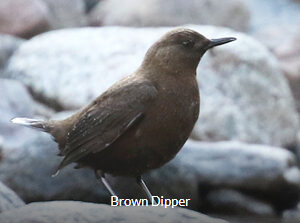
After a good night’s rest we take a day trip out of Almaty to the foothills of the Tien Shan Mountains birding in the traditional farmland and pastures of the Kaskelyn Valley. A fast-flowing mountain stream is home to Blue Whistlingthrush and Brown Dipper as well as the leucogaster subspecies of White-bellied Dipper. In the past we have seen these two species of Dipper side-by-side for comparison.
For European birders there will be a number of familiar birds such as Common Cuckoo, European Bee-eater and European Roller all of which can be seen sitting on roadside cables and fence posts. Siberian Stonechat can be seen in rough vegetation and the highly skulking Corncrake can sometimes be teased out into the open here too. One of our main targets here though is the very attractive Meadow Bunting which is present here in small numbers and can usually be located by its call. Nearby to Meadow Bunting habitat streamside vegetation plays host to White-crowned Penduline Tit, Hume’s Leaf Warbler singing its descending buzzing song and we have our first chance to find cute Azure Tits, a bird that is always a highlight.
This can also be a good area for raptor sightings. Black Kite, Steppe Buzzard and Long-legged Buzzard are common and we can also hope for Golden Eagle, the massive Himalayan Griffon and Lammergeier among others if weather conditions are good for these birds to be in flight. We can also take time to look at local subspecies of birds that are familiar to European bird watchers such as Woodpigeon, Lesser Whitethroat and Common Whitethroat as well as taking our first look at Greenish Warbler in low trees. We will have our first picnic lunch in this scenic area and when we have found all of our target species we will head back to our hotel.
Day 3, Almaty to Kokpek Pass & Sogety Plains – 23rd May 2025
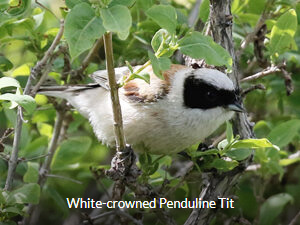
Leaving Almaty after an early breakfast we drive across areas of villages and traditional agriculture where birds are still abundant. In farmland here we have another excellent chance of seeing White-crowned Penduline Tits nesting and there are likely to be plenty of Common Nightingales in song, although they can be difficult to spot. Both European Golden Oriole and Indian Golden Oriole are possible here and we are also likely to come across a number of species that will become familiar along the tour such as Blyth’s Reed Warbler, Ruddy Shelduck and others before moving on to the Kokpek Canyon.
At this remote area rock formations thrust out of the surrounding steppe hosting one of the most attractive buntings of our trip: White-capped Bunting. This lovely little bird often sings from rocky outcrops or small bushes protruding from the crags along a defile and sometimes takes a bit of searching but it is worth it for such a memorable bird. In this area we also likely to see Rock Bunting, Chukar Partridge and Hume’s Lesser Whitethroat while birds such as Lesser Grey Shrike, Pied Wheatear, Isabelline Wheatear and various species of raptors are also lprobable. We will investigate the area thoroughly for the key birds, and maybe a few surprises, taking a walk into some immense landscapes to look for Rock Sparrow before having a field lunch of locally-sourced ingredients.
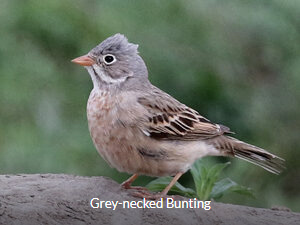
Once we have found our target species we cross the plains where species such as Crested Lark and Isabelline Wheatear are common before attending a small spring in the semi desert where birds collect in the late afternoon to drink and bathe. The bella subspecies of Common Linnet is surprisingly colourful and we hope to see our first Red-tailed (Turkestan) Shrike here too but some of the species we hope to see here are rather more scarce. Mongolian Finch is a regular visitor here and it is also a great spot to find Grey-necked Bunting. Tawny Pipit can usually be seen here flying around and singing from rocks and raptors often include Steppe Eagle. Crimson-winged Finch is certainly far less reliable than it used to be but we do have a chance of seeing this attractive bird here. Rock Sparrow may also come to join the show but the bird we most hope to observe at this watering hole is Pallas’s Sandgrouse. If not successful on the first attempt we do have the opportunity to try again over the coming days.
We continue our journey to our accommodation at an old hunting lodge, having dinner in a nearby village, finding time to spotlight a European Scops Owl.
Day 4, Sogety Plains & Charyn Canyon – 24th May 2025
We can get up early and do some birding around the wooded river valley and farmland that our accommodation is set in before breakfast is served. Birds we might encounter here include the cute Azure Tit, the paropanisi subspecies of Goldfinch (Eastern Goldfinch), Blyth’s Reed Warbler, Common Cuckoo, perhaps another chance at Indian Golden Oriole or even our first White-winged Woodpecker.

After breakfast we head out back onto the Sogety Plains where we will walk among low vegetation in search of one of our main targets; Asian Desert Warbler. This delicate little warbler can be found feeding on insects in the early morning among the vegetation that hugs the ground of the semi desert before disappearing into the dense foliage as the day heats up. While walking across the plains we are likely to come across small numbers of the smart Horned Lark, frequent encounters with Isabelline Wheatear, small groups of Mongolian Finch and we should also look out for Desert Wheatear. Pallas’s Sandgrouse is one of the birds we might have to put some effort into finding and this is another opportunity to find them when feeding on the ground.
Later we make a short drive to Charyn Canyon where Pied Wheatears are usually very obvious and the scenery very spectacular. Grey-necked Buntings hold territories here giving us another chance to see this smart bird while taking a slow journey back through undisturbed habitat gives us a chance to look for Steppe Grey Shrike and better views of any species that we want to see more of.
Day 5, Sogety Plains- Kegen Plains – Karakol – 25th May 2025
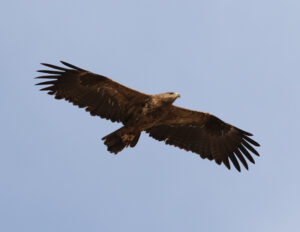
Once again we have a little time for some pre-breakfast birding around our accomodation but there is a long journey ahead of us and some wonderful birding stops along the way to enjoy as we proceed to our accommodation in the small town of Karakol in Kyrgyzstan.
A few short stops in a river gorge and around a village, still on the Kazakhstan side of the border, where we will look for Common Rockthrush, our first Eurasian Skylarks of the trip, Chukar Partridge and Northern Wheatear before reaching the border, set in the middle of a vast wilderness. We can probably start our Kyrgyzstan list with Common Starling and Western House Martin before making a birding stop a short distance into this country. The wide vistas will be set to the song of Corn Bunting, Common Rosefinch and Skylarks with boggy areas hosting stunning Citrine Wagtails. Scanning the skies we can look out for raptors that can include Cinereous Vulture, Black Kite and Steppe Buzzard while we may also be able to see out first Demoiselle Cranes in this amazing setting too. Here we will be able to immerse outselves in the scale of the landscapes in this part of Asia and scan the wetlands and mountains for a variety of birds.
No doubt we will make a series of unscheduled stops as we travel and spot birds along the way, weaving through flocks of livestock driven along by nomads before making another scheduled birding stop in an area of farmland. In many ways standing in an area of agriculture in this part of Kyrgyzstan is like going back hundreds of years with crop rotation still playing a major part of the farming systems with lucerne grown for winter fodder seemingly used as the rotational crop. This means that there is still an abundance of farmland birds with Corn Buntings singing from elevated perches, Common Grasshopper Warblers reeling all around, Common Cuckoo calling from roadside trees along with Siberian Stonechat, Pallas’s Grasshopper Warbler, Paddyfield Warbler, Citrine Wagtail all within the crops and Steppe Buzzards circling overhead. The backdrop of snow-capped mountains adds to the overall atmosphere but the abundance of birds doesn’t leave much time to look at them.
Eventually we will reach our comfortable guesthouse in the town of Karakol in time to check in and take a shower before going for dinner in an excellent restaurant.
Day 6, Chon Ashuu Pass – 26th May 2025
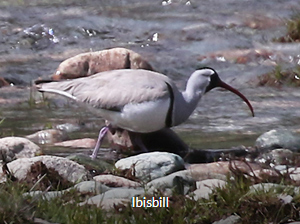
Yesterday’s journey will have taken us through some amazing scenery but be prepared for something even more amazing today. After an early start we head up into the spectacular scenery of the Tien Shan Mountains, stopping along the way to admire calling male Pine Buntings, to search for one of the most iconic birds of such habitats; Ibisbill which is present in small numbers along the meandering mountain rivers along the flat floor of a spectacular glaciated valley. In nearby vegetation the superb Eversmann’s Redstart often lurks providing an impressive splash of colour. Ruddy Shelducks seem to be littered around all over the valley, noisily protecting their ducklings while we should always be on the lookout for Lammergeiers, Golden Eagles and Himalayan Griffons overhead.
There is also the not so small matter of Himalayan Snowcock, which roams the snowy mountainsides and can often be located either by scanning the mountain ridges or tracking it down from its call once up on the snowy mountainsides. In these areas above the treeline there are a variety of specialities to enjoy including the colourful Guldenstadt’s Redstart and a more subtle duo; Altai Accentor and Brown Accentor. In these high places both Alpine and Red-billed Choughs can be seen and while the incredible landscape might take much of our attention we will not forget to look for more sombre species including Plain Mountain Finch and perhaps Brandt’s (Black-headed) Mountain Finch. At thes high altitudes the views along the valleys are spectacular with flocks of livestock grazing on the natural grasslands with the odd nomad family’s yurt dotted around here and there.
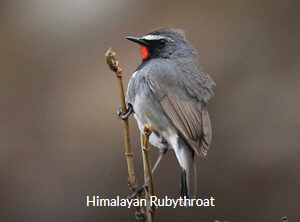
As the day proceeds we will slowly move down the mountain into different ecological zones where in the low shrubbery lurks the beautiful Himalayan Rubythroat, coming out to feed on insects and to declare its territory. Sulphur-bellied Warbler is another key bird that occupies similar habitat as does the colourful Red-mantled Rosefinch. Water Pipit can be found in good numbers in wet areas at this altitude but one of our main targets is the superb White-browed Tit-Warbler. By no means is this an easy bid to find and it can take some persitence, but when it is seen well it is worth the effort. White-winged Grosbeak is often found in these areas, feeding on seeds on low vegetation; another memorable bird when seen well.
On the edge of the treeline we might come across a familar bird in Coal Tit or the more regional smart little Red-fronted Serin. Mistle Thrush, Blue-capped Redstart, Black-throated Accentor and Brown Dipper might be found or we may have to wait until the next day.
We have most of the day to search for our target birds but eventually make our way back to our accommodation in Karakol for dinner.
Day 7, Jety Oguz Forest & Barskoon Pass – 27th May 2025
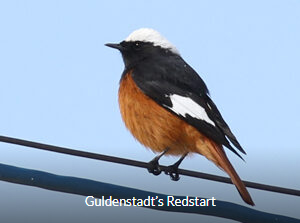
Today we have a drive of about an hour to get to the start of a dirt road that goes along another spectacular valley before eventually heading up into desolate snowy peaks at the Barskoon Pass. The first stop of the day is usually at lower altitude however, where the eastern race of Black Redstart can be found as well as plenty of Northern Wheatears but it is the lovely Fire-fronted Serin that we will be most excited to see, feeding on seeding plants and perched on nearby trees.
Although there is a lot to see along the way we will head directly to the highest elevation to look for any of the species that we did not locate the previous day. The upper Barskoon Pass in an excellent place to see Guldenstadt’s Redstart with a pair occupying a regular territory and we should be able to spot some Hill Pigeons on cliff faces in this region too. Snowy peaks and ice falls set the tone for the scenery up here and it is as imposing as yesterday’s valley was beautiful. Finding Altai Accentor can be difficult so we will put effort into finding it here if not previously seen while Brown Accentor should be far easier. Walking downhill we should come across more Himalayan Rubythroats and certainly Red-billed Chough as well as Alpine Chough. A lunchtime stop at a spot that gives us a great view up and down the valley often turns up flocks of Plain Mountain Finch and a good vista for spotting raptors.
Mixed pine and deciduous woodland and scattered wooded patches further down the valley host a wealth of birds including species familiar to European birders like Common Cuckoo, Goldcrest, Coal Tit, Spotted Nutcracker, European Treecreeper, Eurasian Blackbird and Mistle Thrush to mention a few but also some Central Asian treats including the smart little Blue-capped Redstart and Black-throated Accentor. Although rare, in this habitat we have a chance of encountering Eurasian Three-toed Woodpecker or the regional race of Willow Tit, songarus, which is sometimes given full species status and is known as Songar Tit. In the mountain streams in this area Blue Whistlingthrush, Brown Dipper and White-throated Dipper can all be found while in low vegetation and small trees Black-throated Accentor is a fairly common bird.
Day 8, Karakol Region – 29th May 2025
We have scheduled a third day in this region for several reasons. One is that having traveled so far to such an incredible place it is worth spending more time to take it all in but mostly so that we are not in a rush and have time not only to enjoy the birds we find but also time to search for the ones that make themselves hard to see. There are many options in the area and we could revisit either of the two valleys previously visited for any of the high altitude birds that we may have missed or visit a completely different area where White-browed Tit Warbler is more common.
Having spent a lot of our time at high altitudes we may want more time in the forested areas to look for the species that lurk within them such as Songar Tit or Eurasian Three-toed Woodpecker but one thing is certain, there will be plenty of fantastic birds to enjoy in the most incredible of settings.
Day 9, Karakol – Almaty – 30th May 2025
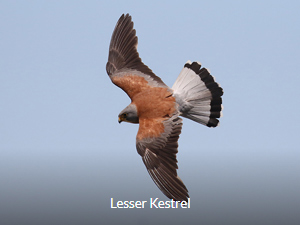
Retracing our steps back to Almaty we will make our first stop in another area of farmland to look for Corncrake. If we did not see this secretive bird at Kaskelen Valley then this is a really good place to connect with it. There should be another chance to see Pallas’s Grasshopper Warbler here as it sings from within tall vegetation and we certainly will not miss Corn Bunting. Turkestan Shrikes, Citrine Wagtails, Common Rosefinch and Eurasian Hobby are all likely too.
With a long way to travel we will move on, passing through the remote border checkpoint again to re-enter Kazakhstan and eventually reach a Muslim cemetary where large numbers of smart Rosy Starlings nest. The masses of birds popping in and out of cracks in the old wall are very impressive but the real reason to visit this spot is for Lesser Kestrel with several pairs forming a small colony here, allowing for great views of this attractive falcon and great photo opportunities for anyone with a camera.
By around 5pm we expect to be at out hotel in Almaty with an early morning departure scheduled for the next day.
Day 10, Sorbaluk Lake – Konshengel – Taukum Desert Camp – 31st May 2025
Leaving Almaty in the early morning we head north out of town through wetland remanants and farmland before the landscape becomes more open and drier. Our first port of call is an area of arable fields and grassland where we hope to find Little Bustard and probably get a our first view of Calandra Lark.
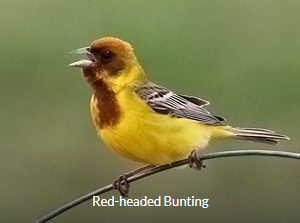
Moving on the short distance to Sorbaluk Lake our main target species is the increasingly rare White-headed Duck. This handsome bird could be lurking in the edges of the main lake itself but more likely we will find it hiding among emergent vegetation in one of the small, marshy satellite pools nearby. In the main lake we will look for flocks of pelicans which should reveal both Great White Pelican and Dalmatian Pelican while groups of Rosy Starlings wheel overhead. We can scan groups of wildfowl which should contain Whooper Swan, Ferruginous Duck and Ruddy Shelduck, to mention but a few, while waders around the lake’s muddy fringes should include Temminck’s Stint, Terek Sandpiper and possibly a few Collared Pratincoles.
Continuing our journey a roadside lunch stop often turns up some interesting species such as Citrine Wagtail, Red-headed Bunting and Calandra Lark all attracted to small pools and puddles. European Bee-eaters usually nest here as well as Spanish Sparrow and in the past we have had great views of Desert Finch here. A few late migrants could pop in to drink but Black-bellied Sandgrouse is more likely. A little closerto our accommodation, at the Yurt Camp, another area where water is available in this arid environment often attracts a variety of species to visit for a drink in the late afternoon. This can be a superb place to see a variety of larks and get to grips with Greater Short-toed Lark, Turkestan Short-toed Lark, Crested Lark and Calandra Lark towering over them all.
By the end of the day we arrive at our Yurt Camp where we have a our first chance of finding Caspian Plover if we scan the grasslands in front of the camp. As the sun sets the yurt camp becomes a wonderful sight before we enjoy some excellent local food.
Day 11, Taukum Desert – Topar & Zheltorangly Turanga Woodland – 1st June 2025
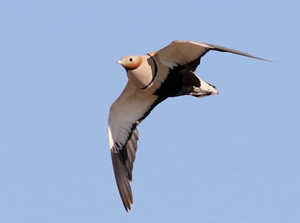
Waking up as the sun rises over the semi desert we are camped in we can scan the surrounding habitat from the camp while we have a morning coffee; perhaps we can spot Black-bellied Sandgrouse or Caspian Plover from where we stand. However, we will not hang around too long as we intend to head off into the best habitat for our main target, but one which is becoming ever more scarce: MacQueen’s Bustard. Our other key species in this area will be both Great Sand Plover and Caspian Plover, unless we have already seen them, with birds such as Brown-necked Raven, Long-legged Buzzard and Calandra Lark all highly likely.
Some of the uncommon birds in this area that we have a chance of finding include Desert Finch, Little Bustard, Blue-cheeked Bee-eater and Bimaculated Lark but by mid-morning we take a fairly lengthy drive to Zheltoangly Turanga Woodland, making a few stops along the way. The road through this semi desert gives us a good chance of finding Rufous-tailed Scrub Robin and there are usually at least a few Steppe Grey Shrikes to be seen. In most years there is a Long-legged Buzzard nest right next to the road with Spanish Sparrows occupying the lower levels of the same nest.
The scattered Turanga trees at our ultimate destination host a few really good birds with White-winged Woodpecker one of the main targets. Even if we have already seen this Central Asian speciality it is likely that we can get extremely good views here. Saxaul Sparrow is another key bird here and one which is surprisingly attractive while Yellow-eyed Pigeon is another range-restricted bird we expect to find at this location as well as Great (Turkestan) Tit. We should be able to enjoy all of these birds before having a picnic lunch here.
On the way back stops at reedy pools give us a chance of locating Black-headed Penduline Tit, although it has become a rare sighting, before returning to our camp.
Day 12, Taukum Desert – Almaty – 2nd June 2025
Once again we will wake up early and see the sun rise over our remote camp, to the sound of Isabelline Wheatears and Calandra Larks in song with accompaniment by Red-headed Bunting. This morning gives us another chance to search for the rare MacQueen’s Bustard as well as Caspian Plover and any of the rarer larks and sandgrouse that we have not yet seen. In nearby scrub we might be able to locate Rufous-tailed Scrub Robin and Syke’s Warbler but our plan for this day will become clearer once we know what we need to focus upon.
After lunch at the camp we start the journey back to Almaty there are a wide variety of places we can stop to look for species not yet seen or to look for any rarer species based on up-to-date local knowledge. We arrive back at our hotel in time to shower, perhaps do a little shopping or relax a bit before dinner.
Day 13, Flight to Astana, Birding Near the City – 3rd June 2025
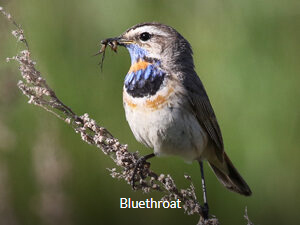
After breakfast we make a short drive to Almaty International Airport where we will take a short flight to the capital city of Kazakhstan: Astana. On arrival we will meet our new driver and check in to our hotel before having lunch. After this, the birding in northern Kazakhstan begins.
Heading out of the city we will hit wetlands and farmland very quickly. In the reedbeds and surrounding scrub there are a wide variety of species to enjoy, including Paddyfield, Blyth’s and European Reed Warblers; quite confusing and something of an education to separate. Booted Warblers are likely to add confusion to this plethora of small brown warblers too. Bluethroat can often be seen singing from the tops of small bushes and Common Reed Bunting making its distinctive call. European Penduline Tits breed in small numbers in this area as do Fieldfares while on the open water we should see species such as Red-crested Pochard and Red-necked Grebe in breeding plumage.
We can check out some shallow margins too for wading birds such as Marsh Sandpiper or Temminck’s Stint while more open areas of land can contain Black-winged Pratincole. Western Marsh Harrier is a common sight over the reeds and we are likely to start to see Hooded Crows which will be common for the rest of the trip.
Day 14, Birding Astana Steppe & Wetlands – 4th June 2025
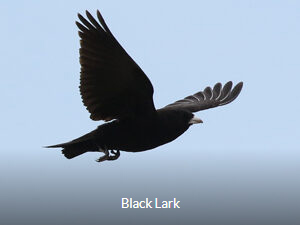
Starting early we head west out of the city of Astana through wet grasslands, reedbeds and agriculture before reaching wide areas of wilderness; steppe grassland with interspersed wetlands in which we can immerse ourselves. Throughout the day there are going to be some real birding highlights with a stop in wet grasslands revealing beautiful Demoiselle Cranes, reeling Common Grasshopper Warblers, Spotted Redshank in breeding plumage among many others but the impressive Black Lark is likely to steal the show.
This large lark will be an exciting sighting but one that will become familiar as the day goes on. The bizarre wing-clapping flight of Black Lark makes this bird even more impressive and one of the more memorable birds of birding tours in Kazakhstan. As impressive as this bird is our attention is likely to be drawn away to also appreciate smaller numbers of White-winged Lark in the same habitat; another really special bird of the region. Western Yellow Wagtail and Tawny Pipit are likely to be in the same area while other birds that are possible include Pallid Harrier, Ortolan Bunting and Short-eared Owl.

We will look out for impressive numbers of Red-footed Falcons perched on roadside wires and trees before stopping in the target zone for one of our key species; Sociable Lapwing. This increasingly rare bird is usually found on agricultural land along our route and we expect to be able to get good views of at least a few of these handsome birds although it could take a lot of searching and patience. In the same area we will be able to enjoy the sight and sound of Black-winged Pratincole as it displays over dry areas of breeding habitat, perhaps alongside Sociable Lapwings.
We will have our lunch alongside a small lake set far away from the hustle and bustle of the modern world where a little islet is home to an impressive colony of Pallas’s Gulls. The island isn’t far away so good views are always to be had but as they fly back and forwards many of them pass very close by, giving us superb views of this magnificent gull. Caspian Gulls will certainly be familiar by now and Steppe Gulls should be easy to locate too. Greater Flamingo is always an impressive bird too and we can expect to see good numbers of them in the same location. More Black Larks will be active around us as we have our picnic lunch while large numbers of Red-necked Phalaropes will be feeding on the lake, many of them allowing us to approach to within a few metres; a superb sight. The supporting cast is made up of species such as Whooper Swan, Great Reed Warbler, Black-winged Stilt and superb White-winged Terns in full breeding plumage.
There will be no hurry to head back to Astana as we will be staying in a guesthouse in Korgalzhyn village not too far away so there should be time to check out smaller areas of reeds for species such as Bearded Tit, Moustached Warbler and Savi’s Warbler; none of these are common but we have the time to look for them or extend our search for Sociable Plover.
Day 15, Birding Astana Steppe & Wetlands – 5th June 2025

Waking up so close to the best birding areas means we do not have to drive far to access top quality habitat after breakfast. This means we will have plenty of time to search for any of the trickier species that may not have revealed themselves to us on the previous day, with Sociable Lapwing being the bird we might have to spend more time on. Northern Lapwings will certainly be easier to see in a variety of wetland habitats and by visiting various lakes, pools and marshy areas we can search for birds such as Slender-billed Gull, waders in breeding plumage such as Ruff and Black-tailed Godwit and a wide range of wildfowl including genuinely wild Greylag Geese.
The time we have out here allows us to make sure we get good views of elegant Demoiselle Cranes, cryptic birds such as Paddyfield Warbler, Black-necked Grebes in breeding plumage, Black Tern, Black-winged Pratincole and spend time looking for any key targets that we may have missed or just simply taking a better look at some of our favourites from the day before.
One of the beauties of this area is just the sheer abundance of birds and it is great to enjoy many sightings of species in full breeding activity and for those who are photographers there are likely to be plenty of good opportunties. We will use this day to ensure that we have had the views we wanted of the key birds as well as add some more widespread birds to our trip list. We will make the most of the day, the habitats and the birds before heading back to Astana. On the final night we will have dinner together, take a vote on bird of the trip and say our goodbyes after enjoying a fantastic Kazakhstan and Kyrgyzstan birding tour.
Day 16, Departure from Astana – 6th June 2025
Transfer to Astana International Airport at a time convenient for the onward flights of all participants to conclude this memorable Central Asia birding tour.
Day 1, Arrival in Tashkent – 16th May 2025
Arrival at Bukhara airport and short transfer to our accommodation in this historic city. We will have dinner in a restaurant in the historic area and discuss the plan for the next day.
Day 2, Tashkent to Chimgan – 17th May
lllll
Day 3, Chimgan to Samarkand – 18th May
kkkkk
Day 4, Aman Kutan – 19th May
hhhh
Day 5, Samarkand to Bukhara – 20th May
jjjj
Day 6, Kyzylkum Desert – 21st 2025
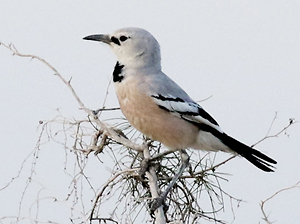
We need to leave town extremely early this morning to ensure we get into the desert shortly after first light, before things get hot and birds become inactive. Turkestan Ground Jay can be an elusive bird but at other times they can be found feeding alongside the road. One thing is for sure, we have some regular spots in which to find them and we plan to be at the most reliable one as early as possible.
Day 7, Jeyran Ecocentre – 22nd May 2025
Leaving the city in the early morning a drive of just over an hour will ensure we arrive at the Jeyran Ecocentre very shortly after first light. This is an area of wetlands, farmlands, pools and riverside vegetation that provides a home to a wide variety of birds given the arid nature of the wider environment here. Close to the headquarters we have a good chance to see Menetries Warbler singing from tussocky vegetation in the early morning
Day 8, Transfer to Almaty – 23rd May 2025
We leave Bukhara in the early hours to board the high speed train to Tashkent. This is a comfortable and quick form of transport and we should reach Tashkent by around nine, with time to fall asleep again on the journey. Due to the scheduling of the train and flights we will have a fair bit of waiting for out flight to Almaty but eventually we should reach our hotel by 5pm Kazakhstan time, which is an hour ahead of Uzbekistan.
Dinner will be in the hotel restaurant where we will meet any members of the group who did not opt for this Uzbekistan extension.
The following is a list of what we consider key bird species on this Kazakhstan birding tour that we have a good chance of seeing based on previous experience. It is not an exhaustive list of birds that we will look for but they are many of the highlights based on range restriction or just how memorable they are. We expect to see a very high proportion of these target birds but cannot guarantee that we can find all of them; conditions and bird abundance change from year to year affecting which birds are present.
Kazakhstan & Kyrgyzstan (Main Tour)
- Himalayan Snowcock – Tetraogallus himalayensis
- White-headed Duck – Oxyura leucocephala
- Greater Flamingo – Phoenicopterus roseus
- Great White Pelican – Pelecanus onocrotalus
- Dalmatian Pelican – Pelecanus crispus
- Lesser Kestrel – Falco naumanni
- Red-footed Falcon – Falco vespertinus
- Lammergeier – Gypaetus barbatus
- Himalayan Griffon – Gyps himalayensis
- Long-legged Buzzard – Buteo rufinus
- Steppe Eagle – Aquila nipalensis
- MacQueen’s Bustard – Chlamydotis macqueenii
- Demoiselle Crane – Grus virgo
- Corncrake – Crex crex
- Ibisbill – Ibidorhyncha struthersii
- Sociable Lapwing – Vanellus gregarius
- Greater Sand Plover – Charadrius leschenaultii
- Caspian Plover – Charadrius asiaticus
- Red-necked Phalarope – Phalaropus lobatus
- Black-winged Pratincole – Glareola nordmanni
- Caspian Gull – Larus cachinnans
- Pallas’s Gull – Ichthyaetus ichthyaetus
- White-winged Tern – Chlidonias leucopterus
- Black-bellied Sandgrouse – Pterocles orientalis
- Pallas’s Sandgrouse – Syrrhaptes paradoxus
- Yellow-eyed (Eversmann’s) Pigeon – Columba eversmanni
- Eurasian Scops Owl – Otus scops
- European Roller – Coracias garrulous
- European Bee-eater – Merops apiaster
- White-winged Woodpecker – Dendrocopos leucopterus
- Turkestan Shrike – Lanius phoenicuroides
- Lesser Grey Shrike – Lanius minor
- Steppe Grey Shrike – Lanius excubitor pallidirostris
- Indian Golden Oriole – Oriolus kundoo
- Turkestan Tit – Parus major turkestanicus
- Azure Tit – Cyanistes cyanus
- White-crowned Penduline Tit – Remiz coronatus
- Calandra Lark – Melanocorypha calandra
- White-winged Lark – Melanocorypha leucoptera
- Black Lark – Melanocorypha yeltoniensis
- Turkestan Short-toed Lark – Alaudala heinei
- Syke’s Warbler – Iduna rama
- Sulphur-bellied Warbler – Phylloscopus griseolus
- Asian Desert Warbler – Sylvia nana
- White-browed Tit-Warbler – Leptopoecile sophiae
- Rosy Starling – Pastor roseus
- Rufous Scrub Robin – Cercotrichas galactotes
- Himalayan Rubythroat – Calliope pectoralis
- Blue-capped Redstart – Phoenicurus caeruleocephala
- Eversmann’s Redstart – Phoenicurus erythronotus
- Guldenstadt’s Redstart – Phoenicurus erythrogastrus
- Desert Wheatear – Oenanthe deserti
- Pied Wheatear – Oenanthe pleschanka
- Saxaul Sparrow – Passer ammodendri
- Brown Accentor – Prunella fulvescens
- Black-throated Accentor – Prunella atrogularis
- Altai Accentor – Prunella himalayana
- “Eastern” Goldfinch – Carduelis carduelis parapanisi
- Red-fronted Serin – Serinus pusillus
- Plain Mountain Finch – Leucosticte nemoricola
- Asian Crimson-winged Finch – Rhodopechys sanguineus
- Mongolian Finch – Bucanetes mongolicus
- Desert Finch – Rhodospiza obsoleta
- Red-mantled Rosefinch – Carpodacus rhodochlamys
- White-winged Grosbeak – Mycerobas carnipes
- Pine Bunting – Emberiza leucocephalus
- White-capped Bunting – Emberiza stewarti
- Grey-necked Bunting – Emberiza buchanani
- Red-headed Bunting – Emberiza bruniceps
Uzbekistan Pre Trip Extension
- Marbled Duck – Marmaronetta angustirostris
- White Stork – Ciconia ciconia
- Pygmy Cormorant – Phalacrocorax pygmeus
- Lammergeier – Gypaetus barbatus
- Himalayan Griffon – Gyps himalayensis
- Shikra – Accipiter badius
- White-tailed Lapwing – Vanellus leucurus
- Black-bellied Sandgrouse – Pterocles orientalis
- Alpine Swift – Tachymarptis melba
- Blue-cheeked Bee-eater – Merops persicus
- White-winged Woodpecker – Dendrocopos leucopterus
- Turkestan Ground Jay – Podoces panderi
- Indian Golden Oriole – Oriolus kundoo
- Turkestan Tit – Parus major turkestanicus
- Azure Tit – Cyanistes cyanus flavipectus
- Rufous-naped Tit – Periparus rufonuchalis
- White-crowned Penduline Tit – Remiz coronatus
- Hume’s Lark – Calandrella acutirostris
- Streaked Scrub Warbler – Scotocerca inquieta
- Syke’s Warbler – Iduna rama
- Eastern Olivaceous Warbler – Iduna pallida
- Upcher’s Warbler – Hippolais languida
- Menetries’s Warbler – Sylvia mystacea
- Eastern Rock Nuthatch – Sitta tephronota
- Rufous Scrub Robin – Cercotrichas galactotes
- White-throated Robin – Irania gutturalis
- Pied Bushchat – Saxicola caprata
- Pied Wheatear – Oenanthe pleschanka
- Finsch’s Wheatear – Oenanthe finschii
- Desert Finch – Rhodospiza obsoleta
- White-capped Bunting – Emberiza stewarti
The map below shows the main locations visited on our route on this Kazakhstan & Kyrgyzstan birding tour. There are quite a number of short stops as we travel along our route and a few side trips from these main birding hotspots.

1. Almaty International Airport
5. Kegen Pass & Plains
9. Zeltorangly Woodland
2. Kaskelen Valley
6. Karakol High Mountain Sites
10. Nur Sultan International Airport
3. Kokpek Pass
7. Lake Sorbulak
11. Korgalzhyn National Park
4. Sogety Plains & Charyn Canyon
8. Taukum Semi-desert Yurt Camp
The following is a selection of bird photos taken on previous tours.
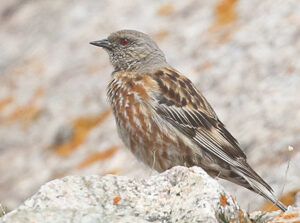
Altai Accentor 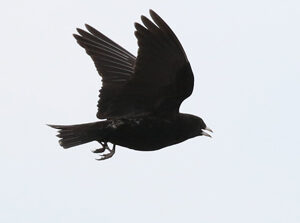
Black Lark 
Blue Whistlingthrush 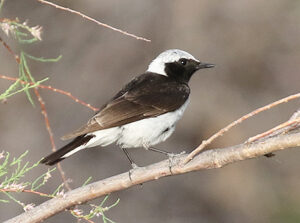
Pied Wheatear 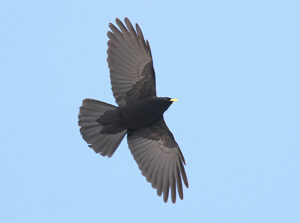
Alpine Chough 
Greenish Warbler 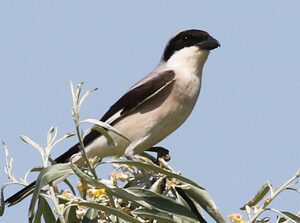
Lesser Grey Shrike 
Brandt’s Mountain Finch 
Eurasian Three-toed Woodpecker 
Laughing Dove 
Blue-capped Redstart 
European Bee-eater
All above photographs copyright Nick Upton/Calidris Birding Tours.
Tour Details
Tour Cost: £TBA
Single Supplement: £500
Included in the tour cost; All transport including airport transfers, accommodation (based on two people sharing a room), Almaty-Nur Sultan domestic flight, all meals, water, national park entry fees and permits, English-speaking birding guide, translator and Calidris Birding Tours guide.
Not included in the tour cost; International flights, travel insurance, visa (most nationalities get visa-free entry for 30 days), alcoholic & soft drinks, tips, hotel mini bar, phone calls, laundry and any other items of a personal nature.
Accommodation: A variety of types of accommodation is used on this tour ranging from comfortable hotels to a very basic hunting lodge and a yurt camp.
Physical effort: This Kazakhstan & Kyrgyzstan birding tour does not require any great physical effort or long walks. However, particpants do need to be fit enough to walk on rough ground and make walks of several hundred metres at altitudes over 2000 metres. Any able-bodied person with decent mobility and moderate fitness levels will be able to take part in this tour. Most birding is done in open country with easy walking. Like any birding tour there will be some long days in the field and a few moderately long journeys.
Weather: The timing of this trip is well into spring and we expect mostly pleasant, temperate conditions, with hot midday temperatures in the semi-desert and steppe. However, a variety of weather conditions should be prepared for with cold weather and even perhaps snow flurries in the high mountains
Food: A variety of styles of food will be encountered on this trip. Evening meals often consist of grilled meat along with a variety of vegetable side dishes while lunches are frequently taken in the field with a variety of locally-made bread, meats, cheeses, salad vegetables and suchlike. Also we encounter more tradional Central Asian dishes that are rice-based as well as meatballs, dumplings and a wide variety of side dishes. Although the local diet is meat-based arranging vegetarian food is not a problem at all, just let us know in advance of this or any other food requirement/allergies.
Tour Leaders

Nick Upton
Nick Upton has been birding since the age of seven and leading birding tours full-time since 2007. After travelling extensively in Asia he settled in Thailand in 1997, teaching English and science while establishing thaibirding.com. With a BSc (Hons) Wildlife & Countryside Conservation he is well placed to understand the ecology of birds as well as the conservation issues that affect them.
Nick is co-founder/director of Calidris Birding Tours.
While we make every effort to adhere to the advertised itinerary for this Central Asia birding tour, we reserve the right to make changes in the case of unforeseen circumstances that are beyond our control. These can include problems with accessibility, national park closures, unseasonal weather events or any other reason that may demand a change of itinerary.
Recommended Field Guide

Birds of Central Asia
Helm Bird Guides have produced many high-quality and easy-to-use field guides over the years and Birds of Central Asia is another of these that we use on our tours. This field guide contains all of the species we are likely to see on this bird watching tour to Kazakhstan & Kyrgyzstan and is small enough to be carried into the field in a large pocket.
The checklist that Calidris Birding Tours will issue for this trip will use IOC taxonomy with the additional reference to the taxonomy used within this field guide so that it is relevant to both. We recommend obtaining a copy of Birds of Central Asia when joining our birding tours to this region as pre-trip reading and for use on tour.
Read our full review of the book here – Birds of Central Asia.
Related Birding Links
- Mountain Birding from Chimgan, Uzbekistan – posted by Nick Upton 08/07/24
- Top 5 Birds of Kazakhstan Birding Tour 2019 – posted by Nick Upton 25/06/19
- Kazakhstan Raptors – posted by Nick Upton 03/06/19
- Birding the Steppe near Astana – posted by Nick Upton 01/06/19
- Birding & Hiking near Shymbulak – posted by Nick Upton 17/05/19
Terms and conditions: Please read full Calidris Birding Tours terms and conditions which apply to this Central Asia Birding Tour.


